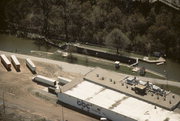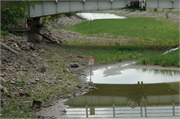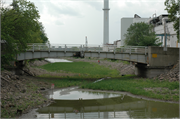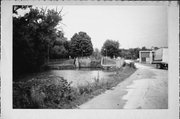Property Record
FOX RIVER E OF S OLDE ONEIDA ST
Architecture and History Inventory
| Historic Name: | |
|---|---|
| Other Name: | APPLETON LOCK #2 |
| Contributing: | Yes |
| Reference Number: | 38990 |
| Location (Address): | FOX RIVER E OF S OLDE ONEIDA ST |
|---|---|
| County: | Outagamie |
| City: | Appleton |
| Township/Village: | |
| Unincorporated Community: | |
| Town: | |
| Range: | |
| Direction: | |
| Section: | |
| Quarter Section: | |
| Quarter/Quarter Section: |
| Year Built: | 1901 |
|---|---|
| Additions: | |
| Survey Date: | 1991 |
| Historic Use: | dam/lock |
| Architectural Style: | NA (unknown or not a building) |
| Structural System: | |
| Wall Material: | |
| Architect: | |
| Other Buildings On Site: | |
| Demolished?: | No |
| Demolished Date: |
| National/State Register Listing Name: | Appleton Locks 1--3 Historic District |
|---|---|
| National Register Listing Date: | 12/7/1993 |
| State Register Listing Date: | 4/10/1992 |
| National Register Multiple Property Name: | Waterway Resources of the Lower Fox River |
| Additional Information: | A 'site file' titled Appleton Locks 1-3 Historic District exists for this property. It contains additional information such as correspondence, newspaper clippings, or historical information. It is a public record and may be viewed in person at the Wisconsin Historical Society, Division of Historic Preservation-Public History. Additional map codes are: FCS 9/11. Additional photo codes are: FCS 9/11,12. The present lock, which is oriented generally on a WSW/ENE axis, was built in 1901 to replace one built of concrete and facing stone in 1878. The 144.6 by 35 foot lock chamber and adjoining wingwalls are comprised of quarried limestone blocks laid in alternating wide and narrow courses, and the walls of the lock are capped with quarried stone coping and a pipe railing. Each of the four lock gates is constructed of squared wooden timbers that are laid horizontally atop one another and joined with structural ties. Adjacent to each gate is a concrete platform that contains a tripod. A vertical shaft extends the height of the tripod. A handle is fixed to the top of the shaft, while the bottom of the shaft contains a gear that drives a horizontally placed spar, the end of which is attached to a lock gate. (It is a hrizontal rack and pinion system.) Depending on which way the handle is turned, the spar is either taken in, thus opening the lock gate, or it is pushed out, in which the gate closes. The chamber is flooded by six butterfly valves that are set in the floor of the structure. As the valves are opened, water passes down into a culvert with a 90 degree turn, which then directs it under the upstream sill and straight into the chamber. Each valve is adjusted by a geared mechanism that sits on the lock's coping. A metal shaft connects the valve to the adjusting mechanism. The chamber is discharged through six butterfly valves found at the bottom of the two downstream gates. There are three valves per gate. These valves are operated by the levers atop each gate. The gates contain a cat-walk that facilitates moving from one side of the lock to the other. The lock provides 9.6 feet of lift as it moves crafts from the 727.36 feet above sea level upper pool to the 716.19 feet above sea level lower pool. It can be filled in three minutes and forty-six seconds, and discharged in two minutes and forty-six seconds. Resurveyed December 2010; no visible changes. |
|---|---|
| Bibliographic References: | (A) Annual Report Upon the Improvement of Rivers and Harbors on Western Shore of Lake Michigan, In charge of J.G. Warren, Major, Corps of Engineers, U.S.A.; being Appendix LL of the Annual Report of the Chief of Engineers for 1901 (Washington, D.C.: Government Printing Office, 1901), 2962. |
| Wisconsin Architecture and History Inventory, State Historic Preservation Office, Wisconsin Historical Society, Madison, Wisconsin |





